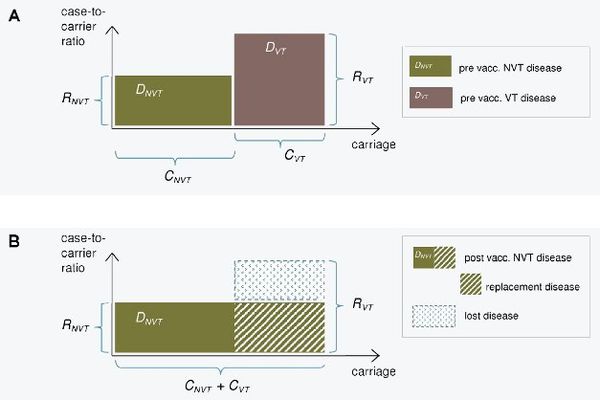Replacement: Difference between revisions
No edit summary |
mNo edit summary |
||
| (2 intermediate revisions by one other user not shown) | |||
| Line 1: | Line 1: | ||
{{encyclopedia}} | |||
[[File: | Serotype replacement means the replacement of the serotypes in the vaccine with serotypes not included in the vaccine. In a vaccinated population the replacement usually happenes reasonably soon after the beginning of the vaccination program. Because of serotype replacement, vaccine effectiveness against invasive disease has been milder than expected. Nurhonen and Auranen have built a model [http://www.ploscompbiol.org/article/info%3Adoi%2F10.1371%2Fjournal.pcbi.1003477], that describes the mechanism of replacement in a vaccinated population. Using the model it is possible to calculate predicted effects of different serotype combinations in a conjugate vaccine against pneumococcal disease in a population and find the serotypes that would be most beneficial additions to current vaccine compositions to prevent invasive pneumococcus disease. | ||
[[File:Model_kuva_simplified2.jpg|thumb|center|600px|'''Figure 1. Illustration of the replacement model.''' The incidence of pneumococcal carriage (x-axis) and case-to-carrier ratios (y-axis) for vaccine serotypes (VT) and non-vaccine serotypes (NVT) before (panel A) and after vaccination (panel B). The incidences of disease (DVT and DNVT) are obtained by multiplication of the two quantities and correspond to the areas of the rectangles. After vaccination, VT carriage is eliminated and replaced by NVT carriage (panel B). The decrease in IPD incidence after vaccination is obtained as the difference between the eliminated VT disease and the replacing NVT disease. This is the area of the blue rectangle in panel B.]] | |||
== See also == | == See also == | ||
{{pneumococcal vaccine}} | {{pneumococcal vaccine}} | ||
Latest revision as of 13:22, 21 August 2014
This page is a encyclopedia article.
The page identifier is Op_en6359 |
|---|
| Moderator:Nobody (see all) Click here to sign up. |
|
|
| Upload data
|
Serotype replacement means the replacement of the serotypes in the vaccine with serotypes not included in the vaccine. In a vaccinated population the replacement usually happenes reasonably soon after the beginning of the vaccination program. Because of serotype replacement, vaccine effectiveness against invasive disease has been milder than expected. Nurhonen and Auranen have built a model [1], that describes the mechanism of replacement in a vaccinated population. Using the model it is possible to calculate predicted effects of different serotype combinations in a conjugate vaccine against pneumococcal disease in a population and find the serotypes that would be most beneficial additions to current vaccine compositions to prevent invasive pneumococcus disease.

See also